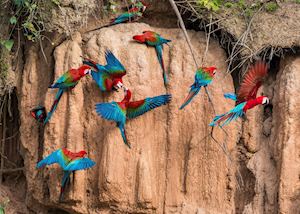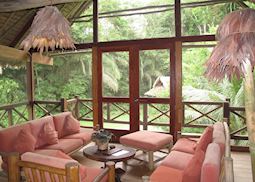Jump to:
Peru’s southern selva promises swathes of barely disturbed lowland rainforest with a smattering of oxbow lakes whose banks sometimes bristle with birdlife, caimans, and capybara. Also within its locale is a particularly pristine, protected area of forest called the Reserva Nacional Tambopata-Candamo (commonly known as the Tambopata Reserve). Here, you can visit colpas (claylicks) — inconspicuous-looking mud slicks containing rich minerals and salts that attract macaws and other small parrots.
 Both in this reserve and along the Madre de Dios and Tambopata rivers, you can stay in isolated yet comfortable lodges that offer guided trips to help you explore the rainforest habitat in depth. Our specialists can suggest ways for how to incorporate an Amazon experience into a wider Peru tour, how to select the right lodge, and how to make the most of your time in one of the planet’s most intriguing biomes.
Both in this reserve and along the Madre de Dios and Tambopata rivers, you can stay in isolated yet comfortable lodges that offer guided trips to help you explore the rainforest habitat in depth. Our specialists can suggest ways for how to incorporate an Amazon experience into a wider Peru tour, how to select the right lodge, and how to make the most of your time in one of the planet’s most intriguing biomes.
The southern portion of the Peruvian Amazon is relatively easy to access, especially compared with other sections of this gargantuan rainforest. Short daily flights from Cuzco and Lima operate to Puerto Maldonado, a once-sleepy frontier town that now acts as a gateway to the Amazon.
Some lodges are little more than a 45-minute canoe trip from Puerto Maldonado; others are farther afield, deeper into the forest, and require a longer journey time. Leaving the main Madre de Dios or Tambopata river behind and slinking off into smaller tributaries can be a thrillingly discombobulating experience. The trees start to close in, and you’re suddenly alert to sounds such as the plopping of nuts into the water (itself blackly impenetrable but never stagnant). In the mornings, you wake to the sounds of howler monkeys and bird calls. The air smells of soil, chlorophyll, and leaf litter, and is heavy with humidity.
Spotting wildlife in the Amazon should always be considered a bonus — visiting it is really all about absorbing what it’s like to be enveloped in a jungle environment.
 The Tambopata Reserve is the southern Peruvian Amazon at its most wild. That’s partly due to its remote location and partly due to the conservation efforts in place there. Along with the claylicks, where you’re likely to see birds such as scarlet macaws gathering in swarms, you may also see tapirs.
The Tambopata Reserve is the southern Peruvian Amazon at its most wild. That’s partly due to its remote location and partly due to the conservation efforts in place there. Along with the claylicks, where you’re likely to see birds such as scarlet macaws gathering in swarms, you may also see tapirs.
These pig-like herbivorous mammals are actually related to the horse family and bear a long trunk-like proboscis. Then there’s the lionfish-like hoatzin bird, a creature which has hardly evolved since the age of the dinosaurs. It can sometimes be seen hopping around the edges of lakes. Its hallmarks are its punky head crest and its displeasing stench — locals call it the ‘stinky turkey’.
On the banks of the rivers just outside Puerto Maldonado, you may spot foraging capybaras, the world’s largest rodent. Meanwhile the region’s oxbow lakes, Lago Sandoval and Lago Valencia, are brimming with piranha and paiché, a giant breed of freshwater fish. You can visit both these lakes on guided trips from your jungle lodge. You know these fish are there, rather than seeing them, but out on a canoe you have a good chance to spot caiman camouflaged against tree roots on the lake’s edge, birds catching fish, and bats roosting in lines along boughs.
who's been there

Start planning your tailor-made trip to the Southern Amazon by contacting one of our Peru specialists
-
617-223-4521617-223-4920
- Make an inquiry
Suggested itinerary featuring the Southern Amazon
This sample itinerary will give you an idea of what is possible when you travel in the Southern Amazon, and showcases routes we know work particularly well. Treat this as inspiration, because your trip will be created uniquely by one of our specialists.
Places near the Southern Amazon
- Sacred Valley 112 miles away
- Machu Picchu 115 miles away
- Cuzco 124 miles away
- Colca Canyon 268 miles away
Photos of the Southern Amazon
Accommodation choices for the Southern Amazon
We've selected a range of accommodation options for when you visit the Southern Amazon. Our choices usually come recommended for their character, facilities and service or location. Our specialists always aim to suggest properties that match your preferences.
-
![Tambopata Research Centre from above]()
Tambopata Research Center
Southern Amazon -
![Hacienda Concepcion]()
Hacienda Concepcion
Southern Amazon -
![Sandoval Lake Lodge]()
Sandoval Lake Lodge
Southern Amazon -
![Reserva Amazonica,Reserva Amazonica]()
Inkaterra Reserva AmazĂłnica
Southern Amazon -
![Comfort Room, Posada Amazonas]() Responsible ChoiceWe've hand-selected a range of tours and stays across the world that go above and beyond to be a force for good by supporting local businesses, educating staff, challenging local norms, or promoting conservation and biodiversity efforts. Your Responsible Choice helps increase the positive impact of your trip.
Responsible ChoiceWe've hand-selected a range of tours and stays across the world that go above and beyond to be a force for good by supporting local businesses, educating staff, challenging local norms, or promoting conservation and biodiversity efforts. Your Responsible Choice helps increase the positive impact of your trip.Posada Amazonas
Southern Amazon -
![Refugio Amazonas]()
Refugio Amazonas
Southern Amazon







